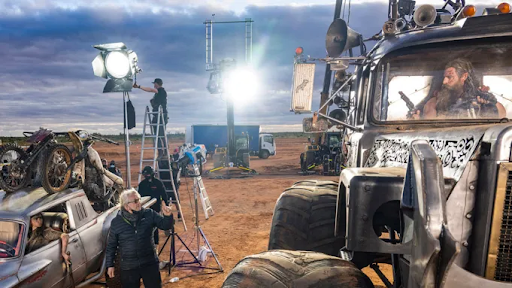Source: The Hollywood Reporter
For the most part, CinemaCon is a time for studios to look forward to the future and make a big spectacle out of all the major releases they have prepared for the upcoming months. First held in 1975 and referred to as the ShoWest Convention (a name that would be changed to CinemaCon in 2011), the event is the creation of the National Association of Theater Owners (NATO), a trade group that consists of many of the nation’s most prominent theater chains that was first founded in 1959. Each year, NATO uses CinemaCon as an opportunity for the major studios to come together and reveal to its attendees (more often than not those with direct ties to the industry overall), acting as an exposition and a trade show where people and businesses with a major stake in Hollywood and its associated goings-on can show off whatever new innovation (whether it’s a new film or an advancement in how one can experience such a film) they have to offer. Progress tends to be first and foremost on the mind for anyone who happens to make their way to CinemaCon (which has historically been held in Las Vegas, with this year’s event taking place at the city’s Caesar’s Palace location), but at the same time, it does make a slight effort to look back from time to time. This is usually whenever CinemaCon seeks to honor any individual whose contributions to the cinematic medium are deemed worthy enough to be recognized with a major accolade, and each year, the event does find the time to hand out at least one of these career achievement awards. The likes of George Lucas, Michelle Yeoh, and countless others have each been fortunate enough to be honored by CinemaCon, and it will be at the most recent convention, currently set to take place next week, will another filmmaker be commemorated for his work. That filmmaker’s name: George Miller.
On Tuesday, April 2nd, CinemaCon announced that in less than a week – specifically on Monday, April 8th during a lunch ceremony – Australian filmmaker George Miller will receive a lifetime achievement award for his decades of contribution to the medium of cinema. In a publically released statement, CinemaCon managing director Mitch Neuhauser praised Miller for his ambitious and innovative approach to cinematic storytelling, referring to the seventy-nine year old auteur as “an archetypal storyteller” who “has transformed the imaginations of moviegoers worldwide, forever altering the cinematic landscape… his filmmaking serves as a testament to his enduring impact and inspiration”. Miller already has plenty to be excited about this year – his newest film “Furiosa: A Mad Max Saga” is set to be released during Memorial Weekend next month (and will likely have a sneak preview shown to CinemaCon attendees) – but the decision to award Miller with a Career Achievement accolade can only make an already exciting time an even greater cause for celebration.
Ironically, Miller himself likely never anticipated any of this growing up in his native Queensland, especially considering that he had initially planned to go down a completely different career trajectory. Although he and his brother Chris would experiment with filmmaking from time to time during his early adulthood (even completing a short film titled “Violence in Cinema: Part 1” in 1971), George had originally set his sights on becoming a medical doctor, having studied medicine at the University of New South Wales and later completing his residency in 1972 at St. Vincent’s Hospital in Sydney. However, it was through his experience as a doctor that Miller found the inspiration for what soon became his most famous cinematic creation. In witnessing a variety of brutal injuries (and more than a few deaths) brought upon by reckless automobile accidents, Miller began to imagine a world where careless driving had gotten prevalent enough for it to be a harbinger of a decaying society, and from that vision, he would craft the film that would seal his fate and make cinema the focal point of his legacy. That film was soon released in Australia during April of 1979; its name was “Mad Max”.
Despite a polarizing critical reception upon its initial theatrical release, its unprecedented box office success more than guaranteed that the film would leave a lasting impact. With a budget no greater than $400,000, “Mad Max” was able to receive roughly $100 million in global ticket sales, making it for a time the single most profitable film ever made. Such success could not go without at least one attempt at being replicated, and in the following years, Miller would expand upon the story he first finished in 1979 with two more sequels: “Mad Max 2” in 1981 (titled “The Road Warrior” for its North American release due to concerns about those who may not have been familiar with the original film) and “Mad Max Beyond Thunderdome” in 1985. Work on a fourth film went in and out of production for the next few decades, with Miller turning his attention towards other films in the time in between, but all that time proved to be more than worth it in the end. Finally released in 2015, “Mad Max: Fury Road” is widely hailed as being Miller’s single greatest cinematic creation to date, with the film’s six Academy Award wins and several other nominations (including Best Picture and Best Director nods for Miller) proving the film was indeed as exceptional as everyone claimed it was.
Of course, there’s more to Miller’s career than just the “Mad Max” films. Among his other works are 1992’s “Lorenzo’s Oil”, which garnered Miller a nomination for Best Original Screenplay; 1995’s “Babe” and its 1998 sequel “Babe: Pig in the City” (Miller only wrote and produced the former, but did also direct the latter); and another family-friendly duology, the 2006 animated feature “Happy Feet” (which gave Miller his first Academy Award win, one for Best Animated Feature) and its 2011 sequel “Happy Feet 2”. These films are certainly a far cry from his more popular “Mad Max” series, but they nonetheless demonstrate Miller’s flexibility as a filmmaker, and they only make it further clear as to why CinemaCon has chosen to honor him with a career achievement award. As the world waits patiently to see how “Furiosa: A Mad Max Saga” fares in comparison to its predecessors, Miller himself will at least be able to find some relief in knowing that whatever happens next, his legacy so far has been nothing short of an impressive feat.




